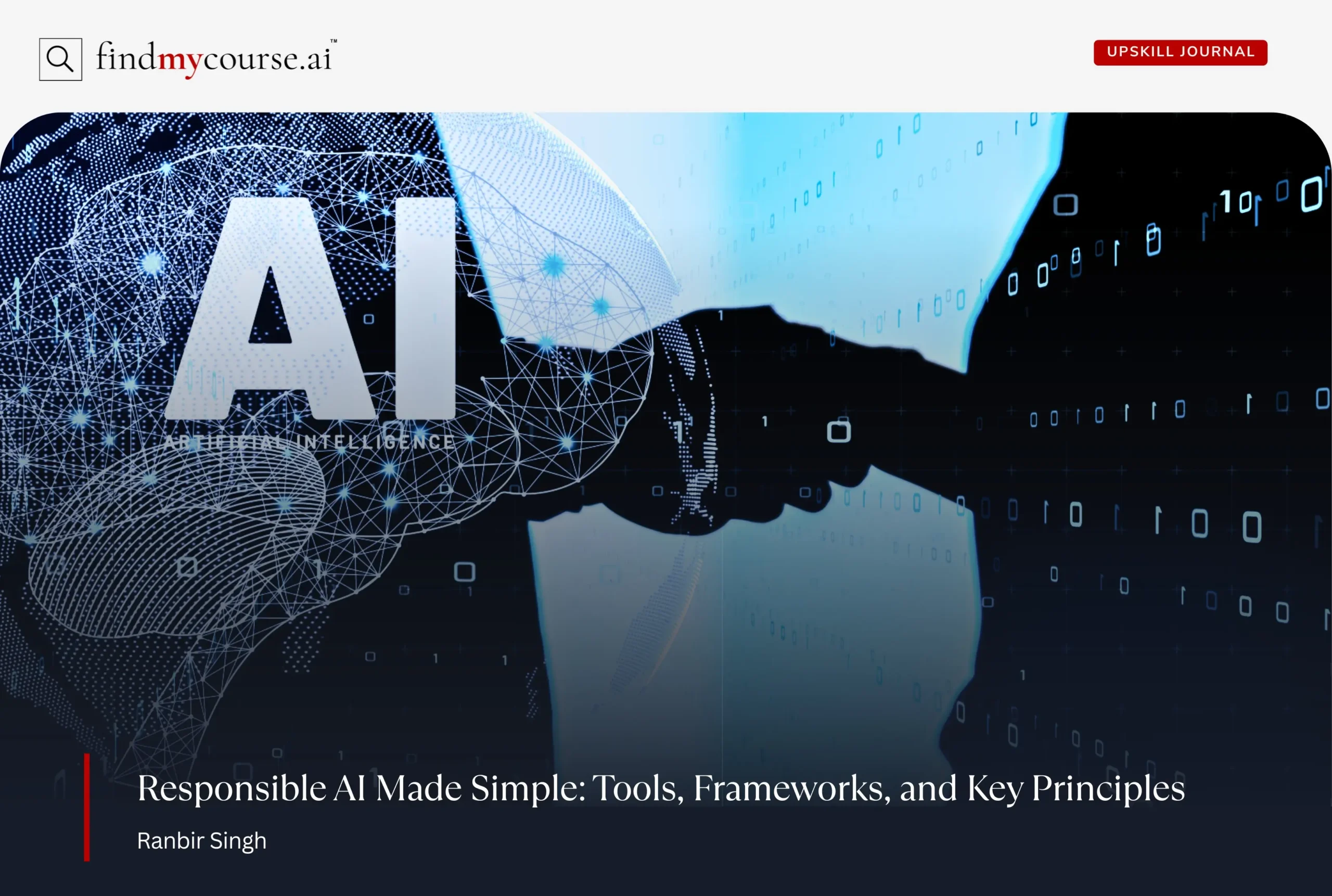Artificial intelligence is now woven into nearly every industry, influencing how we work, communicate, and make decisions. As the pace of innovation accelerates, organizations must ensure that technological progress doesn’t outpace ethical considerations. That’s why building responsible ai systems has become a non-negotiable priority. Moreover, professionals across fields are now exploring how ethical AI design connects to career development, innovation, and even upskilling in tech-driven roles. In this guide, we’ll unpack what responsible AI really means, why it matters, and how to build trustworthy systems that support people—not replace them.
What Is Responsible AI and Its Importance
Responsible AI means designing and using artificial intelligence in ways that are ethical, safe, and aligned with human values. It focuses on fairness, transparency, and protecting people from harm. Because AI can make mistakes or reinforce existing biases, responsible AI ensures systems are carefully monitored, well-designed, and used thoughtfully. It aims to support people, build trust, and create technology that benefits society without causing unintended negative consequences.
Why it Is Important
- Ensuring fairness becomes easier when responsible AI practices help identify and reduce bias, leading to more accurate and equitable decisions.
- Protecting people’s privacy stays a priority because responsible AI sets clear rules for handling data safely and ethically.
- Building trust happens naturally when users understand how AI works and feel confident that the systems are safe and transparent.
- Supporting long-term progress becomes possible as responsible AI keeps up with rapid innovation, aligns with global standards, and helps organizations reduce risks.
Core Principles for Building Responsible AI Systems
When teams start designing AI solutions, they must build on the right foundation. Although every organization may adapt guidelines to fit its goals, several principles consistently appear across reputable industry and government frameworks.
Fairness and Bias Reduction
AI bias can appear in data collection, labeling, training, or deployment. Although perfection is impossible, teams can reduce unfair outcomes by diversifying their datasets, running bias audits, and evaluating models against multiple demographic groups. Moreover, setting fairness thresholds early helps teams agree on acceptable performance levels before systems go live.
Transparency and Explainability
People need to understand how AI reaches a conclusion, especially when those decisions affect hiring, credit scoring, healthcare, or safety. In addition, explainability allows developers to catch errors sooner. Clear model documentation, decision logic summaries, and accessible user-facing explanations all play key roles.
Privacy Protection
With AI models relying heavily on data, privacy must be central to system design. Techniques like differential privacy, data minimization, and strict access controls help protect individuals’ information. Therefore, teams should treat privacy as both a legal requirement and a trust-building strategy.
Accountability
Responsible AI requires clear ownership. Someone must be accountable for every phase—from data selection to model deployment. Moreover, accountability ensures that problems are addressed, not ignored. Establishing escalation paths, audit trails, and impact review boards helps maintain structure as systems scale.
Frameworks That Support Responsible AI Implementation
Adopting responsible ai practices becomes far easier when teams have established frameworks to guide them. These frameworks provide step-by-step direction on ethics, risk assessment, and governance.
Government and Industry Guidelines
Governments worldwide have issued national AI strategies and safety guidelines that emphasize transparency, risk mitigation, and human oversight. Although these guidelines vary, they tend to share core values: protect citizens, promote innovation, and encourage trustworthy AI use. In addition, many educational institutions and research labs have released public tools for evaluating model risk, which helps organizations benchmark their systems against industry standards.
Organizational Governance Models
Companies increasingly create internal governance structures to ensure AI projects follow the right ethical and compliance requirements. These might include AI review committees, cross-functional ethics teams, or mandatory model risk assessments. Moreover, embedding ethics into organizational culture—not just policy—helps teams build solutions that reflect shared values.
International Collaboration Efforts
Global collaboration plays a major role in shaping how AI evolves, because risks and opportunities cross borders. International agreements, safety benchmarks, and shared research help align best practices. Therefore, organizations should monitor updates from multinational coalitions, especially as safety expectations become more standardized around the world.
Best Practices for creating Responsible AI
Creating AI with a human-centered approach means building technology that helps people, not overwhelms them. Instead of focusing only on accuracy or speed, this approach encourages teams to think about real user needs, everyday experiences, and how people interact with the system.
- Focus on Real User Needs
AI should make life easier, not more complicated. Before designing any system, teams need to understand what users struggle with, what they want, and how they make decisions. Talking to users, observing their behavior, and testing early versions of the product help reveal what actually works and what doesn’t.
- Make AI Easy to Understand
People trust technology they can clearly understand. That’s why AI systems should explain what they’re doing in simple, plain language. Whether it’s a recommendation or an automated decision, users should know why it happened. Clear instructions, friendly wording, and transparent explanations make the experience smoother and more trustworthy.
- Keep Humans in Control
No matter how advanced AI becomes, people should always have the final say. Human review adds an important safety layer, especially in sensitive areas like healthcare, transportation, and finance. When humans stay involved in key decisions, systems remain safer, more reliable, and more aligned with real-world values.
Risk Management and Monitoring Throughout the AI Lifecycle
Responsible ai is not a one-time initiative. Instead, it’s a continuous lifecycle that spans conception, development, deployment, and long-term monitoring.
| Lifecycle Stage | What Happens Here | Helpful Tools | Value for the Organization |
| Pre-Deployment Risk Checks | Teams examine ethical, technical, and legal risks before releasing the AI model. They review data quality, fairness issues, and possible negative impacts. | –IBM AI Fairness 360 –Google Model Card Toolkit | Helps organizations avoid costly mistakes, protect users, and ensure the model is safe and ready for real-world use. |
| Ongoing Monitoring After Launch | After the model goes live, teams track accuracy, fairness, performance, and potential drift to spot changes early. | –Fiddler AI -Arize AI | Keeps systems reliable over time, supports better decision-making, and reduces disruptions caused by model failures. |
| Incident Handling & Response | When problems occur, teams follow a structured process to fix issues quickly, communicate clearly, and document incidents. | -PagerDuty -Jira | Minimizes damage, speeds up recovery, and builds stronger, more resilient AI systems through continuous learning. |
Roadmap to Building Your Own Responsible AI Strategy
Every organization approaches responsible AI differently, but having a clear roadmap makes the process easier and more consistent. The steps below offer a practical guide to help teams design, manage, and maintain safe and ethical AI systems.
Step 1: Define Your Values and Goals
Start by clearly stating what responsible AI means for your organization. Think about your values—fairness, transparency, safety—and connect them to real actions, not just broad statements. When teams understand the “why,” they make better decisions throughout development.
Step 2: Build Strong Governance Systems
Responsible AI needs structure. Create committees, review boards, or clear processes that guide how AI decisions are made. Define who approves models, how risks are evaluated, and when issues must be escalated. This ensures consistency and accountability across projects.
Step 3: Encourage Cross-Functional Collaboration
AI affects many parts of an organization, from engineering to legal, design, and leadership. Bringing all these voices together leads to better decisions. Collaboration helps teams spot blind spots early and design solutions that work for both the business and the people who use the product.
Step 4: Use the Right Tools and Frameworks
Practical tools make responsible AI easier to implement. Use fairness-testing tools, explainability dashboards, and privacy checks to evaluate risks. Keep clear documentation through model cards or audit logs so everyone understands how the AI was built and why certain decisions were made. This transparency strengthens trust.
Step 5: Continuously Monitor and Improve
Responsible AI is never “finished.” Once a model is deployed, monitor its performance, fairness, and impact regularly. Update guidelines as new research or regulations emerge. Learn from issues, user feedback, and real-world outcomes to make the system stronger over time.
Common Challenges and How to Overcome Them
Responsible AI work often runs into practical hurdles that can slow progress or create unintended risks. Understanding these challenges helps teams plan ahead and address issues proactively.
- Biased or incomplete data: Real-world data often reflects historical gaps or imbalances. Regular audits, better sampling strategies, and more diverse data sources help reduce unfair or inaccurate outcomes.
- Unclear roles and responsibilities: Without clear ownership, decisions get delayed and accountability weakens. Thus, defining who oversees data, model approvals, and risk checks creates a smoother, more reliable workflow.
- Limited explainability: Some models are difficult to interpret, leaving users unsure how decisions are made. Tools like model cards, transparent documentation, and simpler model components support clearer communication and trust.
- Model drift over time: AI systems can lose accuracy as user behavior or environments change. Continuous monitoring, scheduled evaluations, and feedback loops keep the system aligned with current needs.
Conclusion
Responsible AI works best when it’s treated as an everyday practice, not a final checkpoint. By slowing down to understand real user needs, question design choices, and review risks early, teams create systems that stay useful and trustworthy as they grow. When fairness, transparency, and human oversight are built into each step, AI becomes easier to explain, easier to improve, and easier for people to rely on. In the end, responsible AI isn’t about perfection—it’s also about staying attentive, learning from real-world impact, and building technology that genuinely supports the people who use it.


